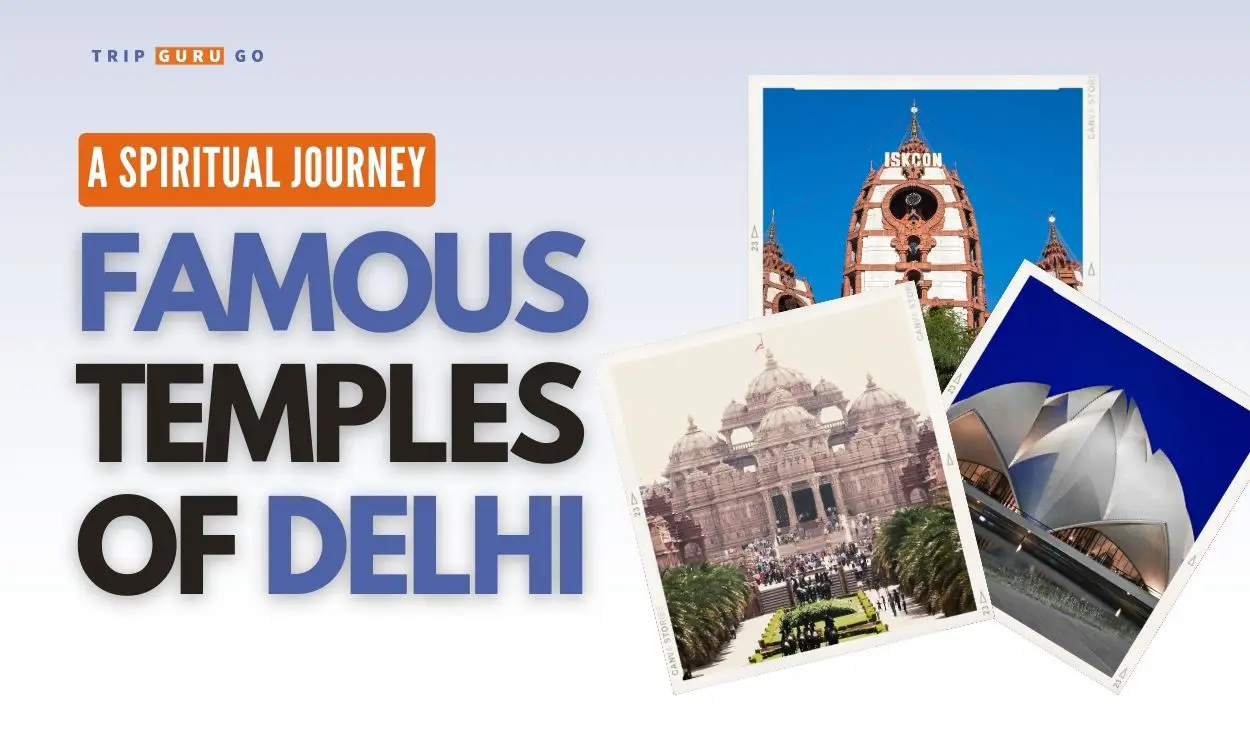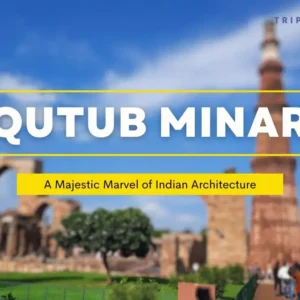Every day, lakhs of tourists come to visit the city of Delhi. Now, these people could be from Delhi or from a distance of several kilometers. They are always looking for the best places to visit in Delhi. People who believe in spirituality are also included in this series. They want to go to a place where they can go with their entire family and children. The famous temples in Delhi are among the destinations that hold a special place in their hearts. Where the mind experiences peace and happiness.
They also use social media or online searches to find spiritual places. So, we have made the work of such people a little easier. In this article, we have included those famous temples of Delhi to visit in 2024 for you. When you go there, you will experience a spiritual connection with God. This article of ours will help you to know about such religious places in Delhi. By reading this article, you can plan your next trip to a spiritual destination.
Why Visit Only These Famous Temples of Delhi in 2024?
Now the question arises: why go to these temples only? Don’t worry; one by one, we will remove all your dilemmas about these temples. These powerful temples in Delhi are famous for their design, inner beauty, and long history. Additionally, these ancient temples in Delhi have fascinating stories linked to them. Due to this, the curiosity to see these temples increases even more. Sir, believe me, when we went and visited all these temples by ourselves, felt peaceful. To find such inner peace in a city as crowded as Delhi was nothing short of a miracle. Come with us now, without waiting, to know the famous temples of Delhi.
Overview of 15 famous Temples of Delhi:
In this episode, we will know which of those famous temples are in Delhi 2024. People of all religions are welcome in all these places. But if you go to these places, you should pay attention to your faith feelings, and views. This is what makes it one of the best places to visit in Delhi in 2024. Each of these buildings has a deep history that shows the culture and natural beauty of Delhi. By the way, there is one or another temple in every corner of Delhi. But we have included 15 of these rare temples. Because, like the holy place of Delhi, it has a different place for getting to know India. Let us know one by one which are the 15 famous temples of Delhi.
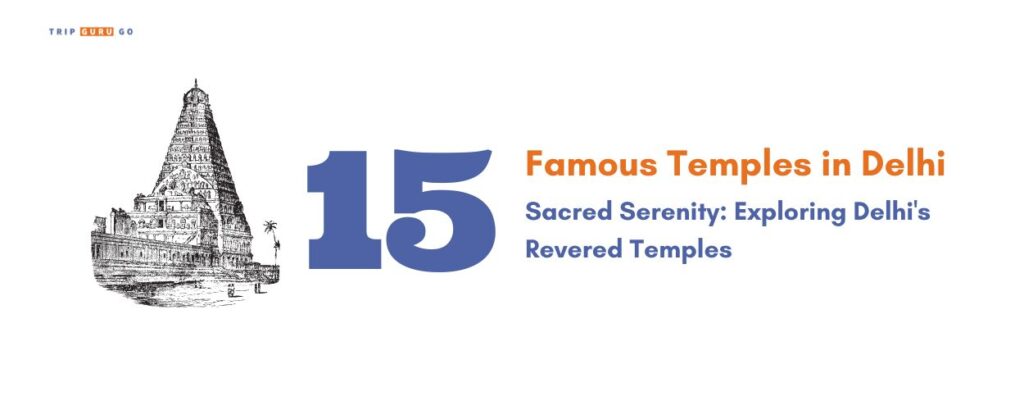
1. Akshardham Temple:

The first number on our list is Swaminarayan Akshardham Temple. It is near the border of Noida (Uttar Pradesh) in East Delhi and stands as one of the remarkable famous temples of Delhi. First of all, we will tell you what Akshardham means. Akshardham’s main “Gate of Salvation,” is Brahmaloka, which is where the Lord lives in person. So, you can say that Akshardham Temple is the place where God’s home is on earth. So it is a spiritual and cultural center of India and also a Hindu temple. The other name for this temple is Akshardham Delhi. The temple complex shows how Hindu culture, religion, and buildings have changed over thousands of years. The BAPS group was responsible for the construction of this temple.
Param Pujya Swami Maharaj and former Presidents Dr. Abdul Kalam, Manmohan Singh, and LK dedicated this temple to the public on November 6, 2005. The people who made this temple made sure to follow Vastu and Pancharatra Shastra. When I went to the premises of this temple, I came to know that there are many types of exhibition halls in it. Which provides us with in-depth information about Swaminarayan’s biography and his outstanding works.
Exhibitions:
According to the information, the temple building also has an Abhishek Mandap, a Sahaj Anand water show, a themed park, and three displays. This temple has the following places worth seeing such as:
- Sahajanand Darshan (Hall of Values),
- Neelkanth Darshan, a short film about Swaminarayan as an adolescent yogi
- Sanskriti Darshan (Cultural Boat Ride)
- 234 carved pillars
- Nine domes and swami
- 20,000 idols of devotees and Acharyas
- Gajendra Peeth at the base of the temple
- 148 life-size elephants weighing 3000 tonnes
- Fountain shows
All these displays are the main attraction of this temple.
What is the Opening and Closing Time of Akshardham Temple?
From Tuesday to Sunday, you can go to Akshardham Temple. The temple is open from 9:30 am to 6:30 pm, with the last entrance at 6:30 pm. The temple closes every Monday. In the temple, there are always different kinds of shows and events going on. For example:
- Darshan and Aarti Timings: Inside the Akshardham Temple, the Darshan times are from 10 am to 8 pm, and the Aarti times are from 10:30 am to 6 pm.
- Abhishek Mandap Timings: Abhishek Darshan & Puja in Akshardham Temple: 10:00 am to 8:00 pm.
- Exhibition Timings: The timings of the exhibitions at Akshardham Temple remain from 11:00 am to 6:00 pm. And the ticket window also remains open till this time.
- Water Show Times: The Water Show at Akshardham Temple takes place after sunset, which is currently at 7:45 pm. Maha Arti takes place before the first show.
How to Reach:
Click on this link to open the exact Google Map location for Akshardham Temple: Google Map Location for Akshardham Temple
You seeing Delhi’s most renowned temple, the Akshardham Temple, would be amazing. So, if you want to go to the temple on the weekend from a nearby part of Delhi, what are you waiting for? If you are from a state far away from Delhi, don’t forget to visit Akshardham Temple when you come to Delhi. If you want more information about the Akshardham Temple, you can click on the link below. You can check out this blog that we have.
2. Lotus Temple:
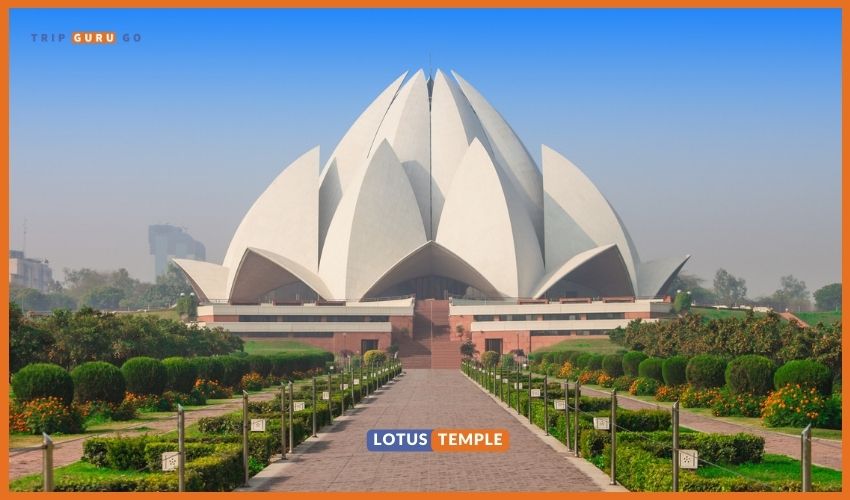
The second famous temple on our list is the Lotus Temple, situated in South Delhi. The local language refers to it as Kamal Ka Mandir due to its lotus flower-like shape. It is a Bahá’í House of Worship located near Nehru Place (Kalkaji Mandir) in South Delhi. We put this temple in second place on our list, because it is a very important place of worship for Baháʼí and famous temples of Delhi.
According to the Baháʼí faith, anyone from any race, group, or religion can pray. Ruhiyyah Khanum started the Lotus Temple on October 19, 1977, when she laid the first stone. The temple was dedicated to the Bahá’í on December 24, 1986. At its opening, about 8,000 Bahá’í from 107 countries, including about 4,000 from 22 Indian provinces, came together. On 1 January 1987, the Lotus Temple opened its doors to the public, attracting over 10,000 visitors that day.
Architecture and Design:
Imagine a peaceful place, like a lotus-inspired temple made of white marble. It has 27 flowers that are all in groups of three. This is a sign of peace. This quiet place is surrounded by sparkling ponds.
Visitor Information:
- Opening Hours: The Lotus Temple is open to visitors from Tuesday to Sunday. It remains closed on Mondays. The Lotus Temple in Delhi is open from 8:30 a.m. to 6:00 p.m.
- Entry Fees: Free of charge.
- Photography: Allowed outside and in designated areas, not inside the prayer hall.
- Guidelines: Maintain silence, and respect the temple’s sanctity.
- Facilities: Visitor center, information desk, bookshop, and cafeteria.
How to Reach Lotus Temple?
The nearest metro station to Lotus Temple is Kalkaji Metro Station. Many Buses go to and from the Kalkaji Mandir Bus Stop, which is near the temple, on a daily basis. In Delhi, it’s easy to find taxis and app-based cab services like Uber and Ola that can take you right to the Lotus Temple.
To access the exact Google Map location for the Lotus Temple. Click on the following link: Lotus Temple Google Map Location
Lotus Temple is a place of peace, unity, and awe-inspiring architecture. Once we say you must visit to feel the peace of mind and unique beauty. To know more about this Lotus Temple, click on the link given below and read a detailed article.
3. ISKCON Temple Delhi:
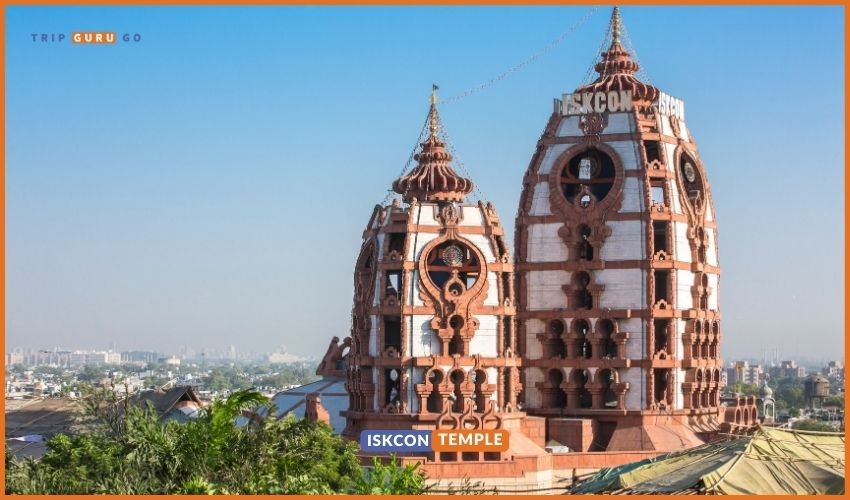
My friends, ISKCON temple comes third in our list of famous temples of Delhi. Before going into detail about it, we want to tell. ISKCON temples are also found in other parts of the country and each temple has its own specialty. The ISKCON temple in Delhi is also known as Sri Sri Radha Parthasarathy Temple. The temple is on Hare Krishna Hill, near Nehru Place in the East Kailash area of Delhi. On 5 April 1998, the Prime Minister of India Atal Bihari Vajpayee inaugurated the temple.
The world’s largest holy book is also present in Delhi’s ISKCON temple. Whose total weight is 800 kg and the measurement is more than 2.8 meters. On February 26, 2019, Prime Minister of India, Shri Narendra Modi, unveiled the world’s biggest holy book to the public for the first time.
ISKCON Temple, also known as Sri Sri Radha Parthasarathi Mandir. It is a prominent spiritual and cultural landmark in Delhi. Here are more details about the famous ISKCON temple in Delhi:
Attractions and Facilities:
- Hare Krishna Restaurant: Located within the temple complex, this vegetarian restaurant offers a variety of delicious and sattvic (pure) meals for visitors.
- Vedic Museum: A museum within the temple complex that showcases the rich Vedic heritage, ancient scriptures, and artifacts related to Krishna consciousness.
- Govind Dev Ji Temple: This famous temple of Delhi, dedicated to Lord Krishna and renowned for its divine aura and spiritual significance, situates nearby.
Visitor Information:
The daily schedule at the temple makes for a well-rounded spiritual experience:
- 4:30 am: Mangala Arati
- 5:15 am: Japa Meditation
- 7:15 am: Darshan Arati
- 7:30 am: Guru Puja
- 8:00 am: Srimad Bhagavatam Discourse
- 8:00 pm: Bhagavad Gita Discourse
- 12:30 pm: Raj Bhog Arati
- 4:15 pm: Usthapana Arati
- 7:00 pm: Sandhya Arati
- 8:30 pm: Sayana Arati
- 9:00 pm: Temple Hall Closure
This pattern gives you time to think, meditate, learn, and be thankful, making for a rewarding day.
- Opening Hours: The ISKCON Temple is open throughout the week. Timings may vary, but generally, it is available from 4:30 AM to 1:00 PM and from 4:00 PM to 9:00 PM.
- Entry Fees: There is no entry fee to visit the temple. The temple accepts donations for maintenance and development.
- Photography: You can take pictures in some parts of the temple building. But you need to get permission to take photos inside the main house.
How to Reach:
The nearest metro station to the ISKCON temple is Nehru Place Metro Station on the Violet Line of Delhi. Buses run from the Nehru Place Bus Terminal, which is near the temple complex. Taxis and app-based cab services like Uber and Ola are available in Delhi. They will take you to the ISKCON temple.
Here’s the link to the exact Google Map location for ISKCON Temple in Delhi: ISKCON Temple, Delhi
If you love Krishna and Radha and believe in Gita, the oldest holy book in the world. By going to this place, you can be swept up in the love for Krishna and have your mind blown. We think you should go to the ISKCON temple at least once if you go to Delhi.
4. Chhatarpur Temple: The Abode of Goddess Durga
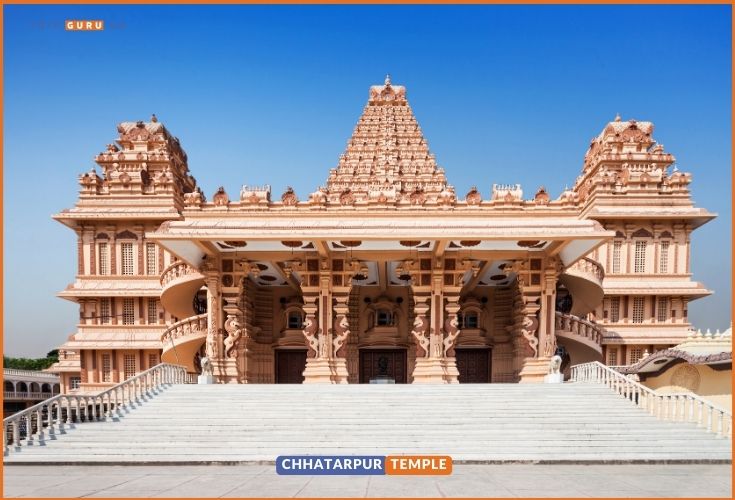
The Chhatarpur Temple, also known as Shri Adhya Katyayani Shaktipeeth Mandir, is one of the largest and most beautiful temples in Delhi. Dedicated to Goddess Katyayani, a form of Goddess Durga, this temple complex boasts magnificent architecture, intricately carved pillars, and serene surroundings. The temple’s serene atmosphere attracts devotees seeking blessings and solace. The premises also house smaller shrines dedicated to other Hindu deities.
Chhatarpur Temple, located in Delhi, is a revered and sprawling temple complex dedicated to Goddess Katyayani. This prominent and famous temple of Delhi has detailed information available.
History and Significance:
The devotees established Chhatarpur Temple, also known as Shri Adhya Katyayani Shakti Peeth Mandir, in 1974. It holds immense religious significance as a revered shrine dedicated to Goddess Katyayani, an incarnation of Goddess Durga. The temple attracts devotees seeking blessings, solace, and spiritual fulfillment.
Architecture and Design:
Chhatarpur Temple showcases exquisite architectural elements inspired by North and South Indian styles. The temple complex encompasses multiple shrines, intricately carved pillars, and stunning domes. The use of marble and granite adds to the grandeur and aesthetic appeal of the temple. The overall architectural splendor leaves visitors mesmerized.
Rituals and Ceremonies:
The temple conducts regular rituals and ceremonies to honor Goddess Katyayani. Devotees participate in arti (devotional prayer), and bhajans (devotional songs), and offer prayers to seek the blessings of the goddess. During festivals such as Navratri, the temple attracts a large number of devotees and holds special celebrations.
Nearby Attractions and Facilities:
- Ashtanayika Temple: The Chhatarpur Temple complex houses a shrine that actively honors the eight principal consorts of Lord Krishna, referred to as Ashtanayikas.
- Hanuman Temple: This temple, dedicated to Lord Hanuman and situated nearby, attracts devotees seeking the blessings of the monkey god.
Visitor Information:
- Opening Hours: Chhatarpur Temple is open throughout the week. Timings may vary, but generally, it is open from early morning until late evening.
- Entry Fees: Visitors do not have to pay an entry fee to visit the temple, but they can make donations for the maintenance and upkeep of the temple complex.
- Dress Code: The temple authorities expect visitors to dress modestly and maintain decorum while inside the temple premises.
How to Reach:
- Nearest Metro Station: The nearest metro station to Chhatarpur Temple is Chhatarpur Metro Station, which is on the Yellow Line of the Delhi Metro.
- Bus Stand: Buses regularly ply to and from the Chhatarpur Bus Stand, which is located near the temple complex.
- Cab Services: Taxis and app-based cab services like Uber and Ola are widely available in Delhi and can take you directly to Chhatarpur Temple.
To visit the Chhatarpur Temple (Shri Adhya Katyayani Shaktipith Mandir) in Delhi, click here for the exact Google Map location.
Chhatarpur Temple provides a serene and divine atmosphere for devotees and visitors to seek blessings and experience spiritual tranquility. Its architectural beauty, religious significance, and cultural heritage make it a must-visit destination for those on a spiritual journey.
5. Kalkaji Temple: Paying Homage to Goddess Kali

A Kalkaji Temple, dedicated to Goddess Kali, is one of the oldest and most revered and famous temples in Delhi. Situated in the heart of the city, this powerful temple holds great spiritual significance for devotees. The temple complex consists of several shrines dedicated to different Hindu deities, with the primary focus on Goddess Kali. The vibrant atmosphere, especially during festivals like Navratri, fills the air with devotion and religious fervor. People from all walks of life come to the temple in search of blessings and divine intervention because they believe that it grants their wishes.
The revered Hindu temple dedicated to Goddess Kali, Kalkaji Temple, is located in Delhi. Here is detailed information about Kalkaji’s famous Temple in Delhi:
History and Significance:
Kalkaji Temple, also known as Kalkaji Mandir or Kalkaji Devi Temple, has a rich history dating back several centuries. It holds great religious significance as a revered shrine dedicated to Goddess Kali, the fierce and powerful form of the goddess. The temple fulfills the wishes of devotees and attracts a large number of worshippers seeking blessings and spiritual solace.
Architecture and Design:
Kalkaji Temple showcases traditional North Indian architectural styles. The temple’s design features intricate carvings, a grand entrance, and a towering shikhara (spire). The main sanctum, dedicated to Goddess Kali, houses the divine idol. The vibrant ambiance, adorned with colorful decorations and religious symbols, creates a captivating atmosphere for devotees.
Rituals and Ceremonies:
The temple conducts regular rituals and ceremonies to honor Goddess Kali. Devotees offer prayers, chant hymns, and participate in arti (devotional prayer) to seek the blessings of the goddess. During the auspicious occasion of Navratri, people particularly revere the temple and worship Goddess Durga.
Nearby Attractions and Facilities:
- Lotus Temple: This Bahá’í House of Worship, known for its lotus-shaped design and tranquil ambiance, stands nearby as an architectural marvel.
- Nehru Place: A bustling commercial hub known for its markets, restaurants, and shopping centers, offering a vibrant shopping experience.
- Okhla Bird Sanctuary: Nature enthusiasts can visit this sanctuary located nearby to witness the rich avian biodiversity and enjoy birdwatching.
Visitor Information:
- Opening Hours: Kalkaji Temple is open throughout the week. Timings may vary, but generally, it is open from early morning till late evening.
- Dress Code: Visitors are expected to dress modestly and maintain decorum while inside the temple premises.
- Photography: Photography is allowed in some regions of the temple complex, but it is advisable to respect the sanctity of the temple while taking photographs.
How to Reach:
- Nearest Metro Station: The nearest metro station to Kalkaji Temple is Kalkaji Mandir Metro Station, which is on the Violet Line of the Delhi Metro.
- Bus Stand: Buses regularly ply to and from the Kalkaji Mandir Bus Stop, which is located near the temple complex.
- Cab Services: Taxis and app-based cab services like Uber and Ola are widely available in Delhi and can take you directly to Kalkaji Temple.
Here’s the exact Google Map location for Kalkaji Temple in Delhi: Click here to view the location
Kalkaji Temple offers devotees and visitors a serene and spiritually charged atmosphere to seek the blessings of Goddess Kali. Its rich history, architectural beauty, and religious significance make it a sacred destination for those seeking divine blessings and a deeper connection with Hindu spirituality.
6. Birla Mandir: A Marvel of Marble
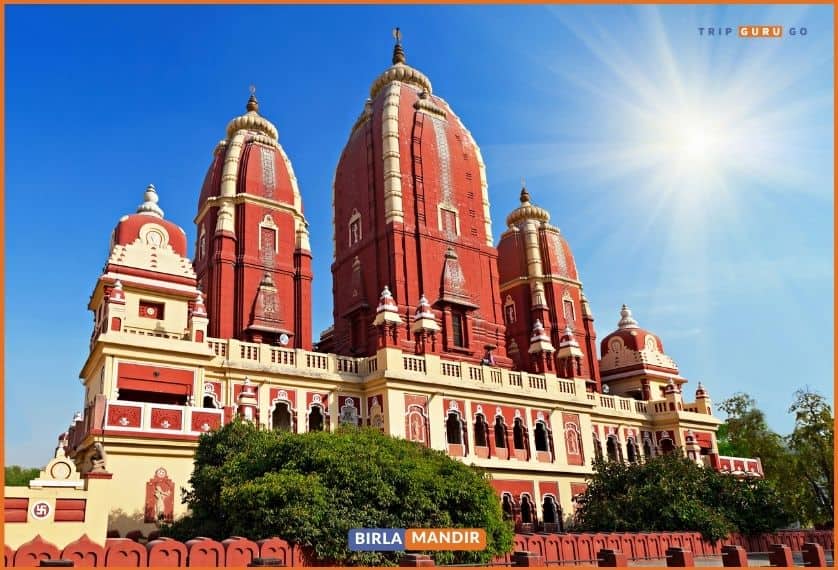
Renowned as a symbol of architectural grandeur, the Birla Mandir, officially known as the Lakshmi Narayan Temple, stands proudly in Delhi. Built by the Birla family, this temple is dedicated to Lord Vishnu and Goddess Lakshmi. The temple complex showcases intricate carvings, ornate sculptures, and beautiful frescoes depicting scenes from Hindu mythology. The serene ambiance and spiritual aura of the temple provide solace and peace to its visitors.
Birla Mandir, also known as Lakshmi Narayan Temple, is a beautiful Hindu famous temple located in Delhi. Here is detailed information about this magnificent temple:
History and Significance:
The illustrious Birla family, well-known for their contributions to philanthropy and art, constructed the Birla Mandir in 1939. The temple holds immense religious significance as it is dedicated to Lord Vishnu and Goddess Lakshmi. It stands as a symbol of devotion and spiritual harmony.
Architecture and Design:
Birla Mandir showcases a unique blend of traditional and modern architectural styles. The temple is constructed using pristine white marble and features intricate carvings and sculptural works depicting scenes from Hindu mythology. The architectural grandeur and attention to detail make it a visual delight for visitors.
Rituals and Ceremonies:
The temple follows regular Hindu rituals and ceremonies to honor Lord Vishnu and Goddess Lakshmi. Devotees offer prayers, perform arti (devotional prayer), and engage in bhajans (devotional songs) to seek the blessings of the deities. The serene ambiance and spiritual aura create a peaceful atmosphere for devotees.
Nearby Attractions and Facilities:
- Connaught Place: Located nearby, Connaught Place is a bustling commercial hub known for its markets, eateries, and entertainment options.
- National Museum: Situated in the vicinity, the National Museum showcases a vast collection of art, artifacts, and historical treasures representing India’s rich cultural heritage.
Visitor Information:
- Opening Hours: Birla Mandir is open throughout the week. Timings may vary, but generally, it is open from early morning until late evening.
- Dress Code: Visitors are expected to dress modestly and maintain decorum while inside the temple premises.
- Photography: Photography is allowed in some regions of the temple complex, but it is advisable to respect the sanctity of the temple while taking photographs.
How to Reach:
- Nearest Metro Station: The nearest metro station to Birla Mandir is Patel Chowk Metro Station, which is on the Yellow Line of the Delhi Metro.
- Bus Stand: Buses regularly ply to and from the Birla Mandir Bus Stop, which is located near the temple complex.
- Cab Services: Taxis and app-based cab services like Uber and Ola are widely available in Delhi and can take you directly to Birla Mandir.
Discover the serene beauty of Shri Laxmi Narayan Temple (Birla Mandir) with just a click!
Birla Mandir offers devotees and visitors a tranquil space for spiritual solace and devotion. Its majestic architecture, religious significance, and serene ambiance make it a must-visit destination for those seeking a spiritual retreat and a deeper connection with Hindu traditions.
7. Bangla Sahib Gurudwara: A Sacred Sikh Shrine

The iconic Bangla Sahib Gurudwara, located in Delhi, is a prominent Sikh place of worship that holds great historical and religious significance. The Gurudwara is associated with the eighth Sikh Guru, Guru Har Krishan Sahib Ji, and is known for its sacred Sarovar (holy pool). Devotees visit the gurudwara to seek blessings, participate in the daily Langar (community kitchen) that serves free meals to all, and experience the spiritual teachings of Sikhism. The gurudwara’s magnificent architecture and the soothing sound of kirtan (devotional hymns) create a tranquil and uplifting atmosphere.
Gurudwara Bangla Sahib, located in Delhi, is a prominent Sikh place of worship and a significant spiritual and cultural landmark. Here is detailed information about this revered Gurudwara:
History and Significance:
Gurudwara Bangla Sahib holds historical importance as it was originally the residence of Raja Jai Singh, a Mughal courtier. It became a Gurudwara in the 18th century and stands as a symbol of devotion and the Sikh faith. The Gurudwara is dedicated to Guru Har Krishan Sahib, the eighth Sikh Guru, who resided here during his stay in Delhi.
Architecture and Design:
Gurudwara Bangla Sahib showcases a blend of traditional Sikh architecture and modern influences. The complex features a beautiful gold-domed main prayer hall, a sarovar (holy water tank), and a langar hall where free meals are served to devotees and visitors. The serene atmosphere and architectural elegance make it a place of tranquility and spirituality.
Rituals and Services:
Regular prayers, hymn recitations, and kirtans (devotional singing) honor Guru Har Krishan Sahib and promote the teachings of Sikhism at Gurudwara Bangla Sahib. The langar, a community kitchen, serves free meals to all visitors, regardless of their caste, creed, or social status, reflecting the principle of equality and selfless service in Sikhism.
Nearby Attractions and Facilities:
- Connaught Place: Situated nearby, Connaught Place is a popular commercial and shopping hub, offering a range of retail stores, eateries, and entertainment options.
- Jantar Mantar: Maharaja Jai Singh II constructed the intriguing architectural instruments at Jantar Mantar, an astronomical observatory that is nearby.
Visitor Information:
- Opening Hours: Gurudwara Bangla Sahib is open throughout the day and night, allowing visitors to seek blessings and engage in prayers at their convenience.
- Dress Code: Visitors are required to cover their heads with a scarf or a head covering before entering the Gurudwara. Scarves are provided at the entrance for those who need them.
- Langar: The langar serves free meals to all visitors, and everyone is welcome to partake in this communal dining experience.
How to Reach:
- Nearest Metro Station: The nearest metro station to Gurudwara Bangla Sahib is Patel Chowk Metro Station, which is on the Yellow Line of the Delhi Metro.
- Bus Stand: Buses regularly ply to and from the Gurudwara Bangla Sahib Bus Stop, which is located near the Gurudwara complex.
- Cab Services: Taxis and app-based cab services like Uber and Ola are widely available in Delhi and can take you directly to Gurudwara Bangla Sahib.
Click here to explore Bangla Sahib Gurudwara on Google Maps.
Gurudwara Bangla Sahib offers a sacred space for Sikhs and visitors of all faiths to experience Sikh traditions, practice meditation, and embrace the principles of equality, selfless service, and devotion. The Gurudwara’s historical significance, architectural beauty, and spiritual atmosphere make it a must-visit destination for those seeking a profound and inclusive spiritual experience.
8. Yogmaya Temple: Where History Meets Devotion
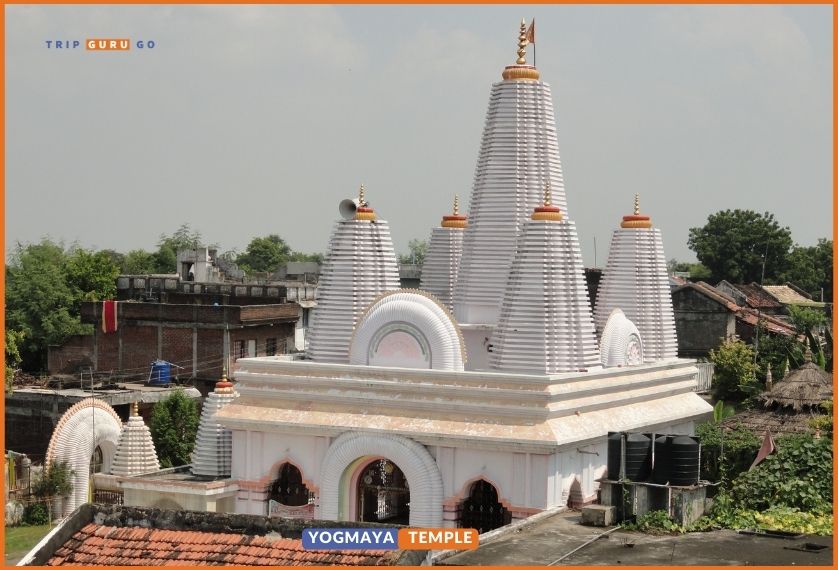
Discover the spiritual allure of Yogmaya Temple in Delhi, an age-old Hindu place of worship honoring Goddess Yogmaya, also recognized as Jogmaya or Jogmaya Devi. Immerse yourself in the divine ambiance and embrace the ancient traditions. Here is detailed information about this sacred temple:
History and Significance:
Yogmaya Temple holds immense historical and religious significance. It is believed to be one of the oldest surviving temples in Delhi, with its origins dating back to the Mahabharata era. The temple is dedicated to Goddess Yogmaya, who is considered the sister of Lord Krishna. The temple’s existence showcases the rich heritage and cultural legacy of the city.
Architecture and Design:
Yogmaya Temple features a unique blend of architectural styles, combining influences from both Hindu and Islamic traditions. The temple’s structure incorporates elements of Nagara and Islamic architecture, with intricate carvings and decorative motifs adorning the walls and pillars. The sanctum houses the idol of Goddess Yogmaya, radiating a sense of divine grace and spiritual energy.
Rituals and Ceremonies:
The temple conducts regular rituals and ceremonies to honor Goddess Yogmaya. Devotees offer prayers, light oil lamps, and floral tributes to seek the blessings of the goddess. The temple atmosphere is filled with the devotional chants and hymns of the devotees, creating a serene and spiritually uplifting ambiance.
Nearby Attractions and Facilities:
- Mehrauli Archaeological Park: Located near the temple, this park houses numerous historical monuments and ruins, providing a glimpse into Delhi’s rich past.
- Qutub Minar: Situated in close proximity, the iconic Qutub Minar, a UNESCO World Heritage Site, stands tall as a magnificent architectural marvel.
Visitor Information:
- Opening Hours: Yogmaya Temple is open throughout the week. Timings may vary, but generally, it is open from early morning until late evening.
- Dress Code: Visitors are expected to dress modestly and maintain decorum while inside the temple premises.
- Photography: Photography is generally permitted. But it’s best to honor the temple’s sanctity and request permission before taking pictures.
How to Reach:
- Nearest Metro Station: The nearest metro station to Yogmaya Temple is Qutub Minar Metro Station, which is on the Yellow Line of the Delhi Metro.
- Bus Stand: Buses regularly ply to and from the Qutub Minar Bus Stop, which is located near the temple.
- Cab Services: Taxis and app-based cab services like Uber and Ola are widely available in Delhi and can take you directly to Yogmaya Temple.
Click here to explore the location of Yogmaya Temple on Google Maps.
Yogmaya Temple offers devotees and visitors a glimpse into Delhi’s ancient history and spirituality. Its architectural beauty, historical significance, and tranquil ambiance make it a serene and sacred place to seek blessings, experience spiritual bliss, and connect with the divine energy of Goddess Yogmaya.
9. Hanuman Temple, Connaught Place: A Spiritual Oasis in the Heart of Delhi
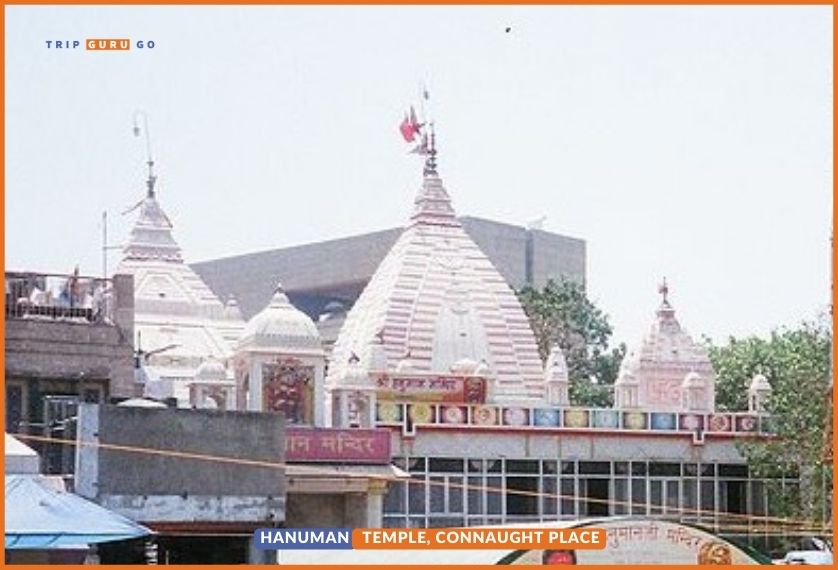
Hanuman Temple, located in the bustling commercial hub of Connaught Place in Delhi, is a revered Hindu temple dedicated to Lord Hanuman. Here is detailed information about this sacred temple:
History and Significance:
Hanuman Temple in Connaught Place has a rich history and holds great religious significance. It is believed to be one of the famous and oldest Hanuman temples in Delhi, dating back several centuries. The temple stands as a symbol of devotion and reverence towards Lord Hanuman, the monkey god known for his strength, devotion, and loyalty.
Architecture and Design:
Hanuman Temple features traditional Hindu architectural styles. The temple’s facade is adorned with vibrant colors and intricate carvings, depicting scenes from the Ramayana and the life of Lord Hanuman. The main sanctum houses the idol of Lord Hanuman, radiating a divine aura and spiritual energy.
Rituals and Ceremonies:
The temple conducts regular rituals and ceremonies to honor Lord Hanuman. Devotees offer prayers, chant hymns, and recite the Hanuman Chalisa (devotional hymn) to seek the blessings and protection of Lord Hanuman. The famous temple of Delhi’s atmosphere is filled with the devotional fervor of devotees, creating a spiritually uplifting ambiance.
Nearby Attractions and Facilities:
- Connaught Place Market: Surrounded by bustling shops, restaurants, and entertainment venues, the Connaught Place Market offers a vibrant shopping and dining experience.
- Jantar Mantar: Located nearby, Jantar Mantar is an astronomical observatory built in the 18th century, featuring fascinating architectural instruments.
Visitor Information:
- Opening Hours: Hanuman Temple is open throughout the week. Timings may vary, but generally, it is open from early morning until late evening.
- Dress Code: Visitors are expected to dress modestly and maintain decorum while inside the temple premises.
- Photography: Photography is generally allowed, but it is advisable to respect the sanctity of the temple and seek permission before capturing images.
How to Reach:
- Nearest Metro Station: The nearest metro station to Hanuman Temple in Connaught Place is Rajiv Chowk Metro Station, which is a major interchange station on the Blue Line and Yellow Line of the Delhi Metro.
- Bus Stand: Buses regularly ply to and from the Connaught Place Bus Terminal, which is located near the temple.
- Cab Services: Taxis and app-based cab services like Uber and Ola are widely available in Delhi and can take you directly to Hanuman’s powerful Temple in Connaught Place.
Click on the Hanuman Temple, Connaught Place location on the map to explore it in action.
Hanuman Temple in Connaught Place provides a tranquil oasis amidst the bustling city, where devotees and visitors can seek blessings, find solace, and connect with the divine energy of Lord Hanuman. Its historical significance, architectural beauty, and spiritual ambiance make it a sacred destination for those on a spiritual quest.
10. Neeli Chhatri Temple: A Hidden Gem of Serenity
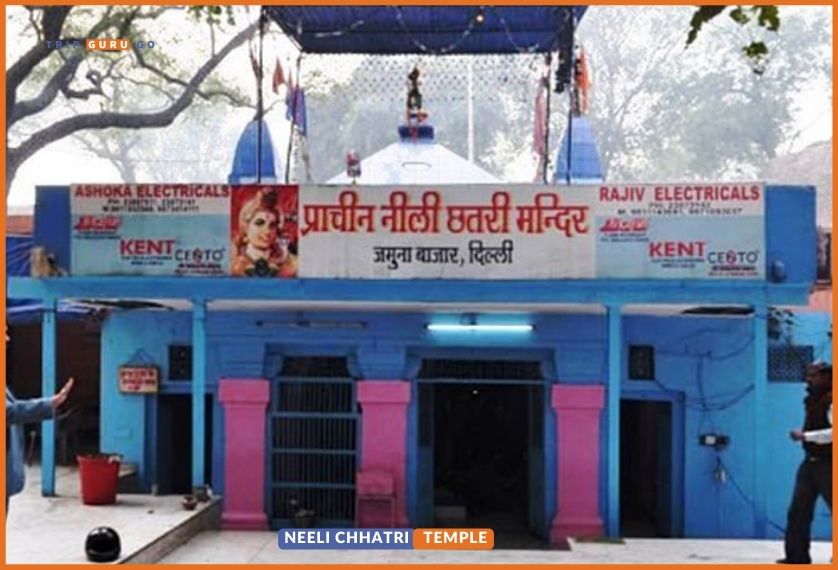
The Neeli Chhatri Hindu Temple, situated in Delhi’s Yamuna Bazar, stands out as a hidden gem, celebrated for its remarkable blue dome. Here is detailed information about this enchanting temple:
History and Significance:
Neeli Chhatri’s famous Temple of Delhi holds a fascinating history and cultural significance. It is believed to have been built during the reign of Maharaja Agrasen, a legendary figure known for his philanthropy and community service. The temple showcases the rich heritage and architectural marvels of ancient India.
Architecture and Design:
Neeli Chhatri Temple stands out for its stunning blue-colored dome, which gives it a distinct identity. The dome is adorned with intricate designs, adding to the temple’s aesthetic appeal. The architecture combines elements of Rajasthani and Mughal styles, creating a unique fusion that is captivating to behold.
Rituals and Ceremonies:
The temple conducts regular rituals and ceremonies, following Hindu customs and traditions. Devotees offer prayers, perform arti (devotional prayer), and offer floral tributes to seek the blessings of the deities. The serene atmosphere and spiritual vibrations create an aura of tranquility and devotion.
Nearby Attractions and Facilities:
- Agrasen Ki Baoli: Agrasen Ki Baoli, located in the vicinity, is an ancient step well that is renowned for its architectural splendor and historical significance.
- Chandni Chowk: A bustling market nearby, Chandni Chowk offers a vibrant shopping experience and is famous for its delectable street food.
Visitor Information:
- Opening Hours: Neeli Chhatri Temple is open throughout the week. Timings may vary, but generally, it is open from early morning until late evening.
- Dress Code: Visitors are expected to dress modestly and maintain decorum while inside the temple premises.
- Photography: Photography is generally allowed, but it is advisable to respect the sanctity of the temple and seek permission before capturing images.
How to Reach:
- Nearest Metro Station: The nearest metro station to Neeli Chhatri Temple is Chandni Chowk Metro Station, which is on the Yellow Line of the Delhi Metro.
- Bus Stand: Buses regularly ply to and from the Chandni Chowk Bus Stand, which is located near the temple.
- Cab Services: Taxis and app-based cab services like Uber and Ola are widely available in Delhi and can take you directly to Neeli Chhatri Temple.
Click on the map to explore the location of Nili Chhatri temple.
Neeli Chhatri Temple offers visitors a unique and captivating experience with its distinct architecture and tranquil ambiance. Its historical significance, stunning blue dome, and spiritual vibrations make it a hidden gem worth exploring for those seeking a spiritual retreat and a glimpse into Delhi’s rich cultural heritage.
11. Kilkaari Baba Bhairav Nath Mandir: A Sanctum of Devotion
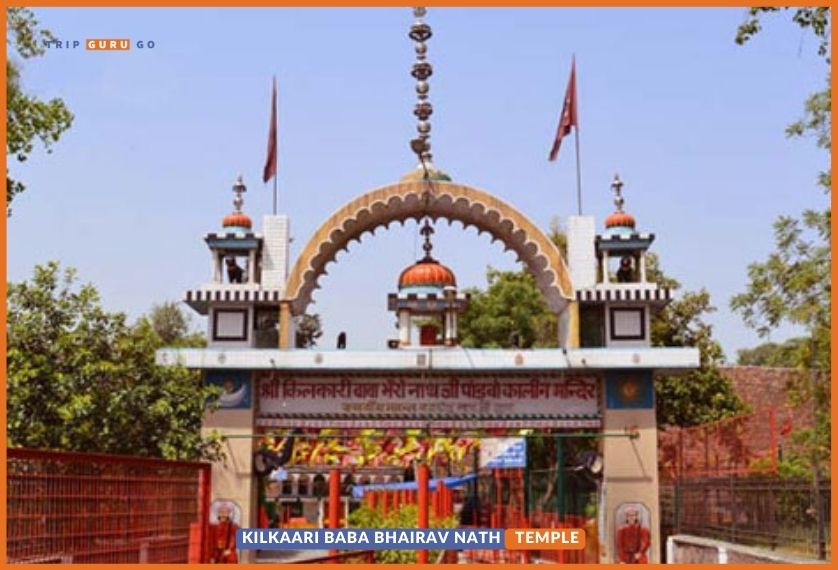
The Kilkaari Baba Bhairav Nath Mandir, situated within the premises of the Purana Qila (Old Fort) in Delhi, is a place of active worship and reverence dedicated to Baba Bhairav Nath. Here is detailed information about this powerful temple in Delhi:
History and Significance:
Kilkaari Baba Bhairav Nath Mandir holds historical and religious importance. Several centuries ago, people believed that they built the temple, showcasing Delhi’s deep-rooted spiritual heritage. They dedicate it to Baba Bhairav Nath, an incarnation of Lord Shiva known for his fierce and protective nature.
Location within Purana Qila:
The temple is located within the premises of Purana Qila, an ancient fort that dates back to the 16th century. Nestled amidst the historical ruins, the temple adds a spiritual essence to the grandeur of the fort complex.
Architecture and Design:
Kilkaari Baba Bhairav Nath Mandir features a simple yet elegant architectural style. The divine presence of Baba Bhairav Nath, believed to reside, imbues the temple structure with intricate carvings and decorative elements, reflecting traditional North Indian architectural influences, where devotees can offer their prayers in the sanctum.
Rituals and Ceremonies:
Devotees visit the temple to seek the blessings and protection of Baba Bhairav Nath. Devotees offer prayers and chant hymns, creating a spiritually uplifting experience as they conduct regular rituals and ceremonies, including abhishek (ritualistic bathing) and arti (devotional prayer), filling the atmosphere with devotion.
Visitor Information:
- Opening Hours: Kilkaari Baba Bhairav Nath Mandir is open throughout the week. Timings may vary, but generally, it is open from early morning until late evening.
- Dress Code: The temple authorities expect visitors to dress modestly and maintain decorum while inside the temple premises.
- Photography: Photography is generally allowed, but it is advisable to respect the sanctity of the temple and seek permission before capturing images.
How to Reach:
- Nearest Metro Station: The nearest metro station to Purana Qila is Pragati Maidan Metro Station, which is on the Blue Line of the Delhi Metro.
- Bus Stand: Buses regularly ply to and from the Pragati Maidan Bus Stand, which is located near Purana Qila.
- Cab Services: Taxis and app-based cab services like Uber and Ola are widely available in Delhi and can take you directly to Purana Qila.
Click on the Google Map location for Sri Kilkari Baba Bhaironath Ji Pandav Kalin Mandir
Kilkaari Baba Bhairav Nath Mandir within Purana Qila offers devotees a unique spiritual experience where ancient history merges with devotion. The temple’s serene ambiance, rich historical surroundings, and the divine presence of Baba Bhairav Nath create an atmosphere of reverence and tranquility, making it a sacred destination for those seeking spiritual solace and a connection with the divine.
12. Uttara Swami Malai Temple: A Slice of South Indian Divinity
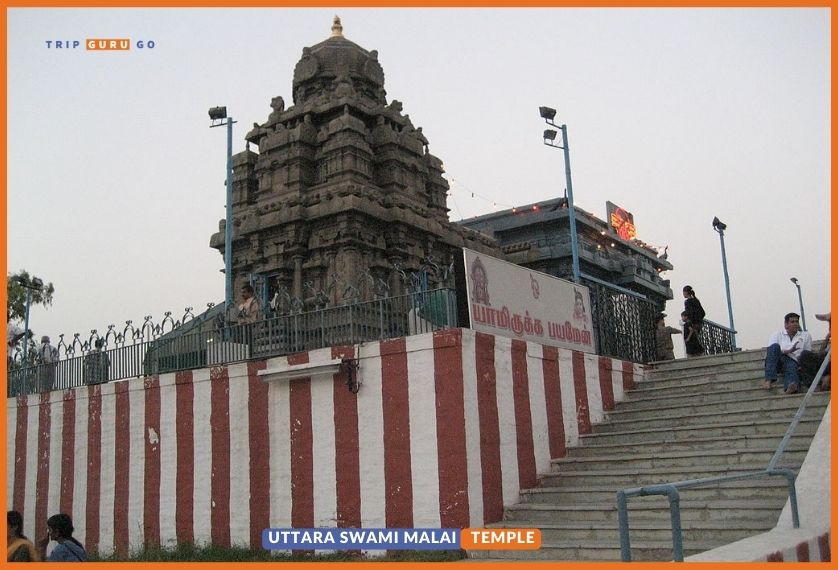
The Uttara Swami Malai Temple, located on Palam Marg in Delhi, reveres Lord Murugan in a South Indian-style temple. Here is detailed information about this divine temple:
History and Significance:
Uttara Swami Malai Temple holds a rich history and cultural significance. The establishment of the temple branch in Swamimalai, Tamil Nadu, aims to bring the essence of South Indian temple architecture and traditions to Delhi, as a part of the renowned Swaminatha Swami Temple. The temple serves as a spiritual sanctuary for devotees seeking the blessings of Lord Murugan.
Architecture and Design:
The temple’s architecture reflects the distinct style of South Indian temples. The ornate gopuram (tower), intricately carved pillars, and vibrant sculptures depicting scenes from Hindu mythology adorn the temple premises. The sanctum sanctorum houses the idol of Lord Murugan, exuding a sense of divine presence and grace.
Rituals and Ceremonies:
Uttara Swami Malai Temple follows traditional South Indian rituals and ceremonies to honor Lord Murugan. Devotees participate in various religious activities, including abhishek (ritualistic bathing) and archana (offering prayers with sacred chants). The temple resonates with the soul-stirring sounds of bhajans (devotional songs) and the aroma of incense, creating an atmosphere of devotion and spiritual bliss.
Nearby Attractions and Facilities:
- DLF Promenade Mall: Located nearby, this upscale mall offers a range of shopping, dining, and entertainment options.
- Palam Vihar Market: Situated close to the temple, Palam Vihar Market is a bustling local market where visitors can explore local shops and experience the local culture.
Visitor Information:
- Opening Hours: Uttara Swami Malai Temple is open throughout the week. Timings may vary, but generally, it is open from early morning until late evening.
- Dress Code: Visitors are expected to dress modestly and adhere to traditional attire while inside the temple premises.
- Photography: It is generally advised to respect the sanctity of the temple and to seek permission before capturing images, although photography is generally allowed.
How to Reach:
- Nearest Metro Station: The nearest metro station to Uttara Swami Malai Temple is Chhatarpur Metro Station, which is on the Yellow Line of the Delhi Metro.
- Bus Stand: Buses regularly ply to and from the Chhatarpur Bus Stand, which is located near the temple.
- Cab Services: Taxis and app-based cab services like Uber and Ola are widely available in Delhi and can take you directly to Uttara Swami Malai Temple.
Explore Uttara Swamimalai Mandir R K Puram by clicking on the map location.
Uttara Swami Malai Temple offers devotees a serene and spiritual haven in the heart of Delhi, allowing them to connect with the divine presence of Lord Murugan. Its unique South Indian architecture, religious rituals, and devotional atmosphere make it a sacred destination for those seeking divine blessings and a taste of South Indian spiritual traditions in the bustling capital city.
13. Shri Digambar Jain Lal Mandir: A Jewel of Jain Devotion
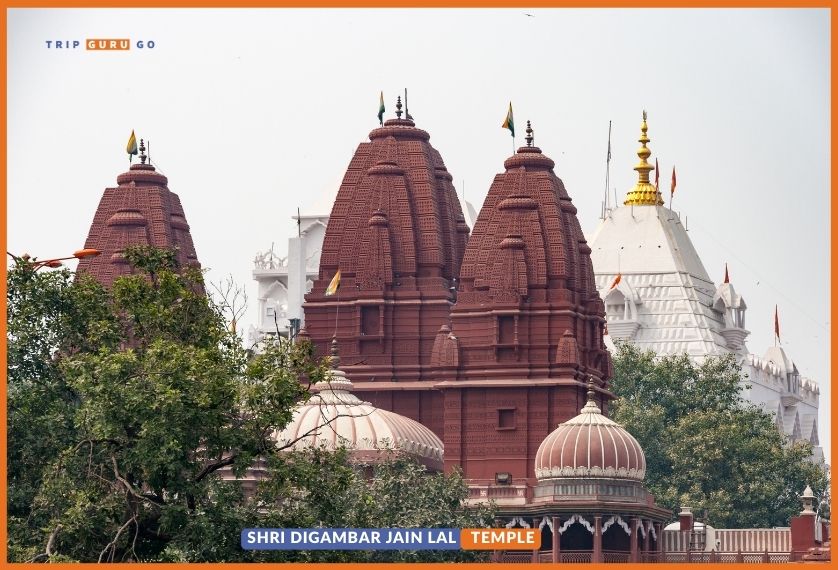
The bustling Chandni Chowk area of Delhi houses Shri Digambar Jain Lal Mandir, a revered Jain temple that actively worships Lord Parshvanath. Here is detailed information about this ancient and sacred temple:
History and Significance:
Shri Digambar Jain Lal Mandir holds immense historical and religious significance. The Jain community believes this temple to be one of the oldest and most famous Jain temples in Delhi, dating back to the 17th century. They dedicate the temple to Lord Parshvanath, the 23rd Tirthankara of Jainism, and consider it an important spiritual center.
Architecture and Design:
The temple exhibits a unique architectural style, blending elements of Jain and North Indian architectural traditions. The red facade of the temple, from which it derives its name “Lal Mandir” (Red Temple), stands out amidst the bustling surroundings of Chandni Chowk. The intricate carvings, colorful paintings, and sculptural works adorn the interiors, reflecting the beauty of Jain art and aesthetics.
Rituals and Ceremonies:
Shri Digambar Jain Lal Mandir follows Jain rituals and customs. Devotees visit the temple to offer prayers, perform abhishek (ritualistic bathing), and recite Jain scriptures. The temple resonates with the melodious chants of Jain mantras and the peaceful aura of meditation, creating a serene environment for spiritual reflection.
Nearby Attractions and Facilities:
- Gauri Shankar Temple: This Hindu temple, situated nearby, dedicates itself to Lord Shiva and garners recognition for its ancient lingam (a symbolic representation of Lord Shiva).
- Paranthe Wali Gali: Located in the vicinity, this iconic lane is famous for its mouthwatering variety of stuffed paranthas (Indian bread) and traditional delicacies.
Visitor Information:
- Opening Hours: Shri Digambar Jain Lal Mandir is open throughout the week. Timings may vary, but generally, it is open from early morning until late evening.
- Dress Code: Visitors are expected to dress modestly and maintain decorum while inside the temple premises.
- Photography: Photography is generally allowed, but it is advisable to respect the sanctity of the temple and seek permission before capturing images.
How to Reach:
- Nearest Metro Station: The nearest metro station to Shri Digambar Jain Lal Mandir is Chandni Chowk Metro Station, which is on the Yellow Line of the Delhi Metro.
- Bus Stand: Buses regularly ply to and from the Chandni Chowk Bus Stand, which is located near the temple.
- Cab Services: Taxis and app-based cab services like Uber and Ola are widely available in Delhi and can take you directly to Shri Digambar Jain Lal Mandir.
Click on the map location for Shri Digambar Jain Lal Mandir to explore.
Shri Digambar Jain Lal Mandir offers devotees and visitors a spiritual retreat amidst the bustling streets of Chandni Chowk. Its rich history, architectural beauty, and religious significance make it a sacred destination for those seeking inner peace, divine blessings, and a deeper understanding of Jain principles and traditions.
14. Jagannath Mandir: A Spiritual Haven

The Jagannath Mandir, located in New Delhi, reveres Lord Jagannath, Lord Balabhadra, and Devi Subhadra as it stands as a dedicated Hindu temple. Here is detailed information about this divine temple:
History and Significance:
Jagannath Mandir holds historical and religious significance. Devotees fervently worship Lord Jagannath, Lord Balabhadra, and Devi Subhadra at the temple, honoring them as incarnations of Lord Vishnu. The temple serves as a spiritual abode for devotees, reflecting the rich cultural heritage of Odisha, where the original Jagannath Temple is located.
Architecture and Design:
Jagannath Mandir showcases the distinctive architecture of Odisha’s temples. The intricate carvings and sculptures on the temple’s facade depict scenes from Hindu mythology. The sanctum sanctorum houses the divine idols of Lord Jagannath, Lord Balabhadra, and Devi Subhadra, attracting devotees with their heavenly presence.
Rituals and Ceremonies:
The temple follows traditional rituals and ceremonies to honor Lord Jagannath and seek his blessings. The temple priests and devotees perform daily prayers, arti (devotional prayer), and bhajans (devotional songs). People celebrate special festivals like Rath Yatra, dedicated to Lord Jagannath’s chariot procession, with great enthusiasm and devotion.
Nearby Attractions and Facilities:
- Lodhi Garden: Situated nearby, Lodhi Garden is a serene park that houses several historical monuments and offers a peaceful environment for relaxation and recreation.
- India Gate: Located in close proximity, India Gate is a prominent national monument that commemorates the soldiers who sacrificed their lives during the Second World War.
Visitor Information:
- Opening Hours: Jagannath Mandir is open throughout the week. Timings may vary, but generally, it is open from early morning until late evening.
- Dress Code: The temple authorities expect visitors to dress modestly and maintain decorum while inside the temple premises.
- Photography: Photography is generally allowed, but it is advisable to respect the sanctity of the temple and seek permission before capturing images.
How to Reach:
- Nearest Metro Station: The nearest metro station to Jagannath Mandir is Hauz Khas Metro Station, which is on the Yellow Line of the Delhi Metro.
- Bus Stand: Buses regularly ply to and from the Hauz Khas Bus Stand, which is located near the temple.
- Cab Services: Taxis and app-based cab services like Uber and Ola are widely available in Delhi and can take you directly to Jagannath Mandir.
Click on the Google Map location for Jagannath Mandir to explore the temple.
Jagannath Mandir offers devotees a sacred space for spiritual solace and devotion. Its unique architectural style, religious rituals, and the divine presence of Lord Jagannath, Lord Balabhadra, and Devi Subhadra make it a significant destination for those seeking divine blessings, cultural experiences, and a connection with Hindu spirituality.
15. Shree Khatu Shyam Dham Mandir: Devotion in the Lap of Nature
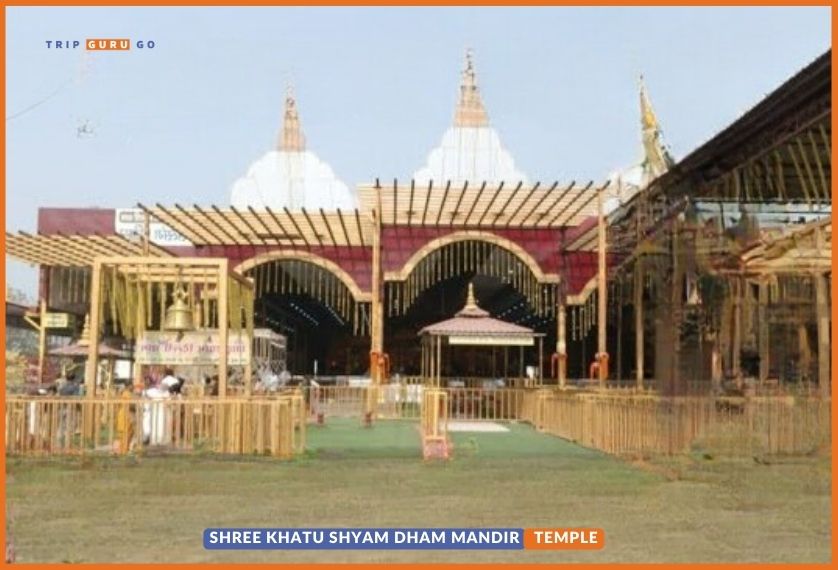
The revered temple dedicated to Lord Khatu Shyam is Shree Khatu Shyam Delhi Dham Mandir, located on GT Karnal Road in Alipur, Delhi. Here is detailed information about this divine temple:
History and Significance:
Shree Khatu Shyam Delhi Dham Mandir holds immense historical and religious significance. Devotees revere Lord Khatu Shyam, a manifestation of Lord Krishna, for his grace and blessings, and they dedicate the temple to him. The temple serves as a spiritual sanctuary for devotees, offering solace and divine intervention in their lives.
Architecture and Design:
The temple showcases traditional Indian temple architecture. The intricately carved exteriors and vibrant decorations create an ambiance of divine beauty. The divine idol of Lord Khatu Shyam radiates spiritual energy with its adorned splendor.
Rituals and Ceremonies:
Shree Khatu Shyam Delhi Dham Mandir conducts regular rituals and ceremonies to honor Lord Khatu Shyam. Devotees gather to offer prayers, perform arti (devotional prayer), and recite hymns and mantras to seek the blessings of the deity. The temple atmosphere resonates with devotion and spiritual fervor during festivals and special occasions dedicated to Lord Khatu Shyam.
Nearby Attractions and Facilities:
- Adventure Island: Situated nearby, Adventure Island is a popular amusement park offering thrilling rides, water attractions, and entertainment options for visitors of all ages.
- Majnu Ka Tilla: Located in close proximity, Majnu Ka Tilla is a vibrant Tibetan colony known for its Buddhist monasteries, authentic Tibetan cuisine, and colorful markets.
Visitor Information:
- Opening Hours: Shree Khatu Shyam Delhi Dham Mandir is open throughout the week. Timings may vary, but generally, it is open from early morning until late evening.
- Dress Code: Visitors are expected to dress modestly and maintain decorum while inside the temple premises.
- Photography: Photography is generally allowed, but it is advisable to respect the sanctity of the temple and seek permission before capturing images.
How to Reach:
- Nearest Metro Station: The nearest metro station to Shree Khatu Shyam Delhi Dham Mandir is Jahangirpuri Metro Station, which is on the Yellow Line of the Delhi Metro.
- Bus Stand: Buses regularly ply to and from the Jahangirpuri Bus Stand, which is located near the temple.
- Cab Services: Taxis and app-based cab services like Uber and Ola are widely available in Delhi and can take you directly to Shree Khatu Shyam Delhi Dham Mandir.
Please click on the Google Map location for Shree Khatu Shyam Delhi Dham Mandir.
Shree Khatu Shyam Delhi Dham Mandir Seek Lord Khatu Shyam’s blessings in a sacred space. Lord Khatu Shyam’s divine energy draws seekers seeking solace and connection to Delhi’s serene and significant spiritual destination.
Conclusion
In conclusion, Delhi’s famous temples not only serve as places of worship but also stand as architectural marvels and cultural treasures. They provide a spiritual escape and offer a glimpse into the city’s religious diversity and heritage. Don’t miss visiting these temples for solace, architectural beauty, or a deeper understanding of Indian culture.
FAQs
Yes, most of the temples in Delhi welcome people of all religions and beliefs. They promote inclusivity and provide a serene environment for everyone.
Absolutely! These famous temples attract a significant number of tourists. Visitors can explore the architectural beauty, participate in rituals, and soak in the spiritual ambiance.
While some popular temples may have an entry fee for certain attractions or exhibitions within their premises, the main prayer areas are usually free for visitors.
It is recommended to visit the temples throughout the year. But visitors should prefer weekdays or early mornings to avoid crowds and experience a more peaceful environment.
The Akshardham Temple is the biggest temple in Delhi. The magnificent Hindu temple complex, renowned for its grand architecture and spiritual significance, stands as an awe-inspiring testament.
The oldest temple in Delhi is the Yogmaya Temple, also known as the Jogmaya Temple. It is located in Mehrauli and dates back to the Mahabharata era.
The Lotus Temple, officially known as the Bahá’í House of Worship, is one of the most famous temples in Delhi. The unique lotus-shaped architecture of the place of worship serves people of all religions.
The Birla Mandir, also known as the Laxminarayan Temple, is the second-largest temple in Delhi. Lord Vishnu and Goddess Lakshmi dedicate it, and it showcases intricate carvings and beautiful sculptures.
Thanks for viewing.

